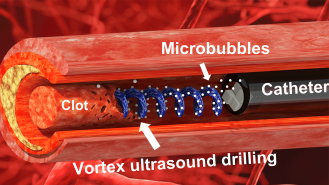When it comes to dealing with blood clots in the brain, speed is of the essence.
While clots in arteries cut off the vital supply of blood, clots in veins put pressure on the blood vessels of the brain, potentially leading to broken blood vessels leaking into the cerebral tissue — a hemorrhage.
Researchers at NC State and Georgia Tech have developed a new method for eliminating a type of brain blood clot that forms in the brain’s veins faster than previous techniques. The key is using “vortex ultrasound.”
“In other words, the ultrasound is swirling as it moves forward,” Xiaoning Jiang, a professor of mechanical and aerospace engineering at NC State, said.
Speed is of the essence when dealing with blood clots in the brain.
Blood on the brain: The team’s technique, published in Research, is designed to treat a certain type of blood clot called a cerebral venous sinus thrombosis (CVST). A CVST occurs when a blood clot clogs up the brain’s venous system, preventing blood from draining properly.
When a CVST results in a hemorrhage, it can lead to stroke. CVST is a relatively rare cause of stroke — accounting for an estimated 0.5% to 0.7% — but it is unusual compared to strokes in arteries because it is more commonly seen in young adults and children.
Existing techniques for removing a CVST “rely in large part on interventions that dissolve the blood clot,” Chengzhi Shi, an assistant professor of mechanical engineering at Georgia Tech and co-corresponding author of the study, said in a statement.
But these techniques are slow.
“Based on available data, pharmaceutical interventions to dissolve CVST blood clots take at least 15 hours, and average around 29 hours,” Shi said.
Current surgical procedures are also not geared towards the venous tissues of the brain, whose diameter is larger than the arteries.
According to Jiang, these current CVST treatments fail in 20% to 40% of cases.
Using vortex ultrasound, where the waves spiral ahead, the team could clear clots in the lab up over 63% faster than normal ultrasound techniques, and hours faster than pharmaceutical interventions.
Ultrasound, with a twist: The team’s prior research into using ultrasound waves to break up blood clots utilized typical, forward-facing waves.
But when squared up against large clots capable of completely blocking blood vessels, previous ultrasound techniques have yet to prove capable of restoring proper, unobstructed flow in less than 30 minutes.
Vortex ultrasound, with the waves sent spiraling at the clot like an invisible drill, was at least 63.4% faster than non-vortex ultrasound, the authors wrote.
“Based on our in vitro testing, this approach eliminates blood clots more quickly than existing techniques, largely because of the shear stress induced by the vortex wave,” Jiang said.
When tested in the lab using a 3D-printed model and bovine blood, the team found that they could clear the completely blocked, 7.5 cm long model in within eight minutes. When the device was tested in collected samples of bovine veins, it was found to not damage the tissue.
The team’s next step is to test their technique in an animal model; if successful, they hope to begin clinical trials. If the vortex ultrasound technique were to become available, Shi expects that it will cost no more than current interventions.
We’d love to hear from you! If you have a comment about this article or if you have a tip for a future Freethink story, please email us at [email protected].






